Can we make sorghum production more reliable in western zones?
Take home message
- Grain sorghum offers the opportunity to include a summer rotation crop, rotate herbicide chemistry, split labour, split logistics and importantly, increase cash flow
- Ensuring profitable, low risk sorghum production in western regions remains a challenge in some seasons
- Early sown sorghum reduces the risk of crop exposure to heat and moisture stress at critical flowering and grain fill periods through altering the crop growth pattern, water use and time to flowering
- Solid plant offers more advantages in seasons where yields are likely to be above 3.0 t/ha. Using skip or wide row configurations can potentially reduce the risk of crop failure by saving soil water for post anthesis but can also limit yield potential
- Growers should target establishing plant populations close to 5.0 plants/m2
- Additional trial data should be generated this coming season, which will help provide localised data around crop water use and flowering windows for a range of hybrids.
Sorghum in western zones – its not a new thing!
Grain sorghum has been grown in north west New South Wales (NW NSW) for many years. In the last 20 years sorghum production peaked in 2005-6 when an estimated 100,000 ha was planted to sorghum (NSW DPI grains report 2012). In 2000-2010, the average area planted to sorghum in NW NSW was approximately 25,000 ha, with yields averaging just over 2 t/ha.
In the last decade, the area planted to sorghum has been considerably reduced, with growers increasingly planting to both chickpea and cotton, due to less perceived growing risk and higher returns. One of the main challenges in recent years has been growing profitable sorghum in an increasingly variable climate, where periods of extreme heat and moisture stress seem to be more common.
Since 2017, the Grains Research and Development Corporation (GRDC), University of Queensland (UQ), NSW Department of Primary Industries (DPI) and Queensland Department of Agriculture and Fisheries (QDAF) have partnered in a research program to test the boundaries of sowing sorghum earlier than usual (or ‘earlier than is generally recommended’)and measuring the impacts on plant establishment, crop development, grain yield and quality. Research trials have been conducted in central and southern Queensland (Qld) as well as Moree, Mungindi and the Liverpool Plains in northern NSW.
The aim of this research was to generate new data that would increase the confidence of growers to include sorghum in rotations in the western zones.
Early sowing – pros and cons
Establishment
Traditionally the sorghum planting window commences in early -mid September when soil temperatures reach 16 -18°C. We have conducted trials over the last three seasons where we have planted sorghum when soil temperatures are at a minimum of 12°C, that is, commencing sowing in early -mid August at sites north and south of Mungindi and north of Moree.
These trials have proved that early sowing is possible, but success is dependent upon:
1. Ability to source high quality seed (germination and vigour)
The largest factor impacting on seed establishment in our trials has been the inherent seed germination and vigour. Results of seed quality testing of our trial seed to date has shown high variability in seed lot germination percentages (Figure 1) between hybrids, seedlots and across temperatures. More significant differences in germination appeared between hybrids with germination reducing as temperature increased from 15 to 35 °C.
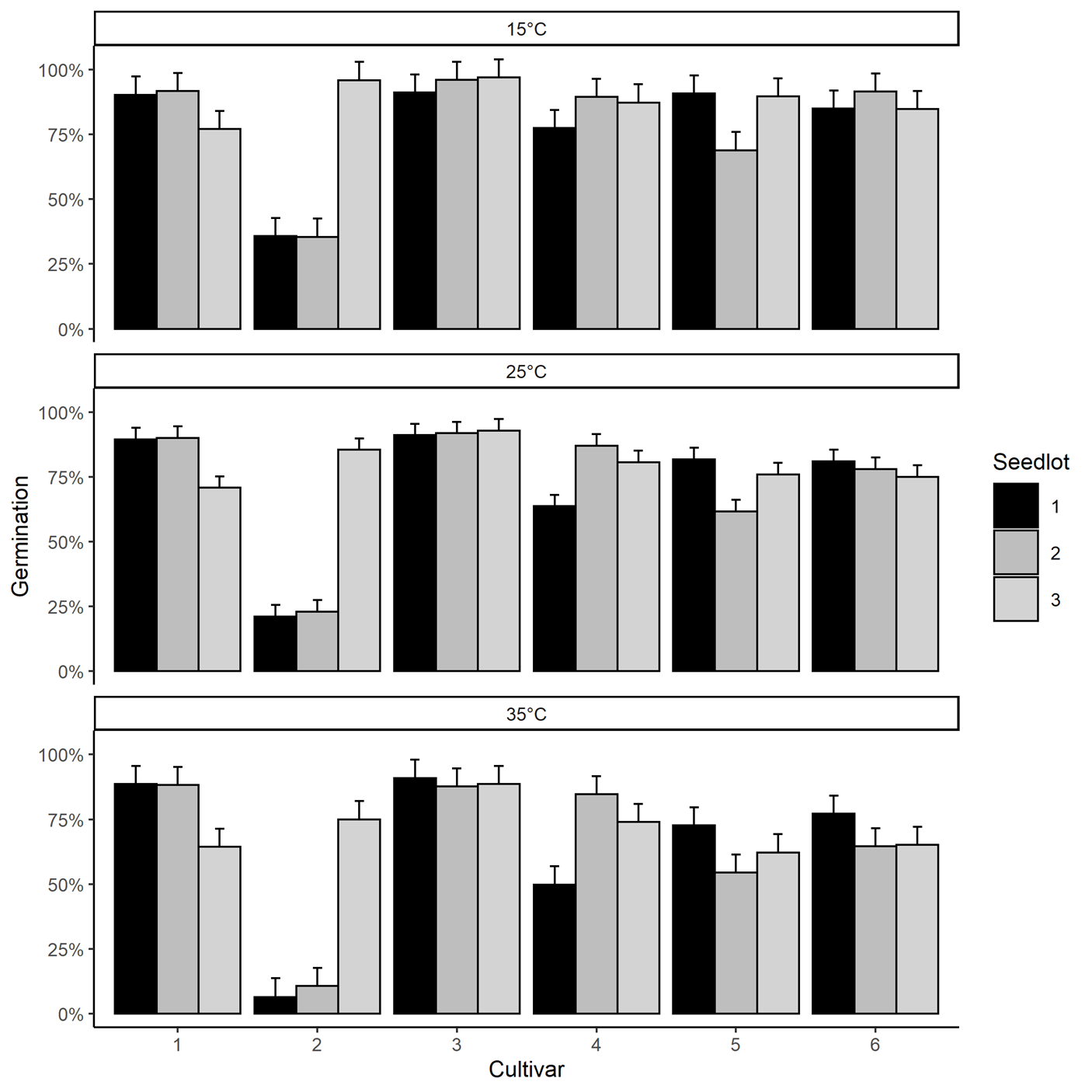 Figure 1. Germination percentage for each genotype and seedlot used in trials between 2018 and 2021 at 3 temperatures. Seedlot 1 was sourced in 2018-19, seedlot 2 was sourced in 2019-20 and seedlot 3 was sourced in 2020-21. Seed was kept in cool storage until evaluation in 2020. Error bars show pooled standard error (n=4).
Figure 1. Germination percentage for each genotype and seedlot used in trials between 2018 and 2021 at 3 temperatures. Seedlot 1 was sourced in 2018-19, seedlot 2 was sourced in 2019-20 and seedlot 3 was sourced in 2020-21. Seed was kept in cool storage until evaluation in 2020. Error bars show pooled standard error (n=4).
While variability in seed quality is expected based on varying production conditions and is managed by seed companies to the best of their ability, the challenge for growers and advisors is obtaining information on their seed prior to planting. As is often said, “you can’t manage what you don’t know”. This becomes more difficult when there is a lack of a standardised commercial test to accurately measure the germination seed vigour on seed lots prior to planting.
2. Acceptance of reduced establishment percentages
Commercial planting rates are usually calculated on an expected seed establishment percentage of around 80%. Our trials have shown that early sowing results in much lower seed establishment percentages. This could be attributed to several factors including
- Colder soil temperatures
- Longer time for seed to imbibe and emerge
- Disease/pests or
- Inadequate soil moisture around the seed to complete the process.
At “Bullawarrie” Mungindi in 2020-21, the average establishment percentage from actual seed sown was 31% for time of sowing 1 (TOS1), sown on the 4th August. This was in comparison to 78% from time of sowing 2 (TOS 2) sown on the 1st September (Figure 2). Establishment percentages were averaged across hybrids and populations. Soil temperatures (average soil temps) for the 7 days following sowing were 9.3 and 14.7 ° C at 8 am for TOS 1 and TOS 2 respectively. Differences in hybrid establishment have been correlated with the germination percentage of the seed. There have therefore been no significant differences between hybrids establishment under cold conditions. Additional research is planned this season to test alternative methods to improve establishment in the field.
 Figure 2. Percent of established plants from actual seeds sown at "Bullawarrie” 2020-21. Legend shows actual target plant population (per m2). Data obtained from plant counts collected at 35-38 days post sowing.
Figure 2. Percent of established plants from actual seeds sown at "Bullawarrie” 2020-21. Legend shows actual target plant population (per m2). Data obtained from plant counts collected at 35-38 days post sowing.
3. Monitoring of soil temperatures at sowing depth
Soil temperatures can fluctuate widely during late winter and early spring (Figure 3). These fluctuations are exacerbated at shallower soil depths as there is less insulation against the changing day/ night temperatures.
Growers looking to plant early sorghum should target soil temperatures of at least 12°C and rising for a period of 7 days. Soil temperature needs to be measured at the intended sowing depth and at the same time e.g. 8 am EST.
 Figure 3. Soil temperatures at "Bullawarrie" Mungindi in 2020-21. Soil temperatures were measured at sowing depth.
Figure 3. Soil temperatures at "Bullawarrie" Mungindi in 2020-21. Soil temperatures were measured at sowing depth.
4. Adequate soil moisture around the seed
Early sowing of sorghum into cooler soil temperatures, means a longer period is required for the seed to imbibe and emerge compared to a normal sowing time. In most cases, sowing in early – mid August results in an emergence time of 2-3 weeks.
As such, there needs to be adequate moisture at planting to ensure the seed does not dry out and stop the germination process. This could exacerbate plant stand uniformity issues and further reduce establishment.
Flowering
The advantages of being able to plant and establish sorghum in August in western areas largely relate to moving the flowering window forward into mid-late November when average maximum temperatures are lower. An earlier flowering window reduces the risk of heat stress and reduced pollen viability from high temperatures. Conditions were better for TOS 1 flowering (light grey dotted box) in 20-21, despite the spike in temperatures in mid-November (Figure 4). Average maximum temperatures were higher during the flowering window of TOS 2 (black dotted box).
Early sown sorghum is slower to move through the vegetative growth stages, meaning it takes more days to reach 50% flowering. However, the aim of early sowing is still to move the flowering window forward. This was demonstrated at “Bogamildi” Moree, when comparing time of sowing 1, 2 and 3 (Figure 5).
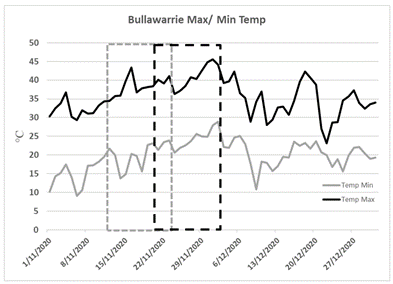 Figure 4. Maximum and minimum temperatures at "Bullawarrie" Mungindi in 2020-21. Dashed boxes indicates the flowering window of TOS 1 (grey) and TOS 2 (black).
Figure 4. Maximum and minimum temperatures at "Bullawarrie" Mungindi in 2020-21. Dashed boxes indicates the flowering window of TOS 1 (grey) and TOS 2 (black).
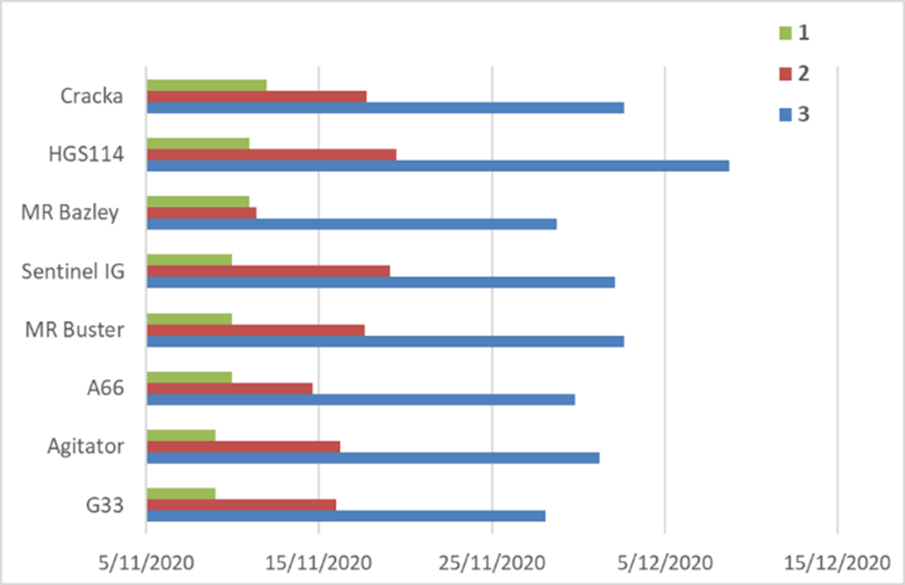 Figure 5. Flowering dates at "Bogamildi" Moree in 2020-21. Time of sowing dates were (1) 5th August, (2) 2nd September and (3) 28th September.
Figure 5. Flowering dates at "Bogamildi" Moree in 2020-21. Time of sowing dates were (1) 5th August, (2) 2nd September and (3) 28th September.
Row configuration and plant population
Changing plant population or row configuration are probably the easiest management levers to pull. The ideal plant population for growing sorghum in NW NSW is influenced by the yield potential and sowing date. Trials conducted by NSW DPI and GRDC have included plant populations from 1.5 – 7.0 plants/m2 across four row configurations; solid 1m, single skip, super wide (1.5 m) and double skip. Plant populations were maintained regardless of the row configuration.
Where crop yields are likely to be > 3.0 t/ha, solid plant will provide higher yields. If a grower is achieving 2.5 to 3t/ha on a skip row configuration, the data suggests that a solid plant configuration would most likely increase yield by 0.5 -1 t/ha, or higher (Figure 6). At yields below 2.5 t/ha, responses to varying row configuration and plant population are less common (Figure 7).
In general, the higher the yield potential of the crop, the higher the plant population which can be supported. However, populations of 5 plants/m2 can achieve yields close to 5.0 t/ha in NW NSW (e.g. Mungindi 10/11 – Figure 6), which is a much higher than average yield in this environment. Populations above 5 plants/m2 (i.e. 7 plants/m2) rarely produced statistically significant higher yields (data not shown) but incur an increased expense due to additional hybrid seed costs.
Plant populations below 3 plants/m2 have been lower yielding in higher yield potential seasons and are also more difficult to achieve even plant distribution across a paddock.
In contrast, at grain yields under 3.0 t/ha, responses to plant population and row configuration tend to be flatter (Figure 7). Some advantages have been seen from very low populations (i.e. 1.5 plants/m2). At these yields, responses to row configuration are also less than generally believed, particularly when yields are < 1.0 t/ha which usually indicates terminal moisture stress.
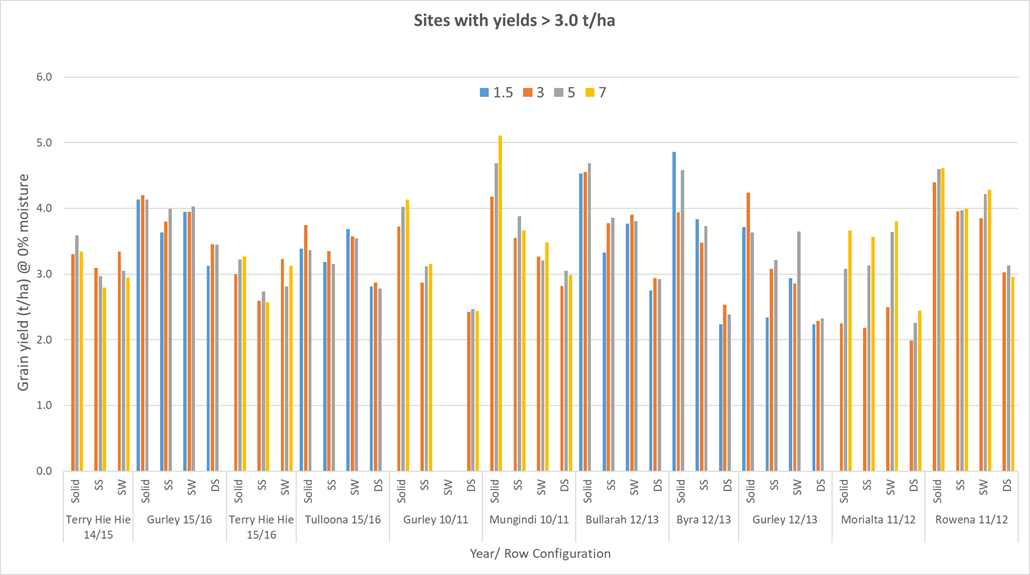 Figure 6. Trial sites with grain yields > 3.0 t/ha. Response to varying plant population (plants/m2) and row configuration in sorghum across north west NSW from 2010-2016
Figure 6. Trial sites with grain yields > 3.0 t/ha. Response to varying plant population (plants/m2) and row configuration in sorghum across north west NSW from 2010-2016
(Solid = solid plant, SS = single skip, SW = super wide (150 cm solid) DS = double skip).
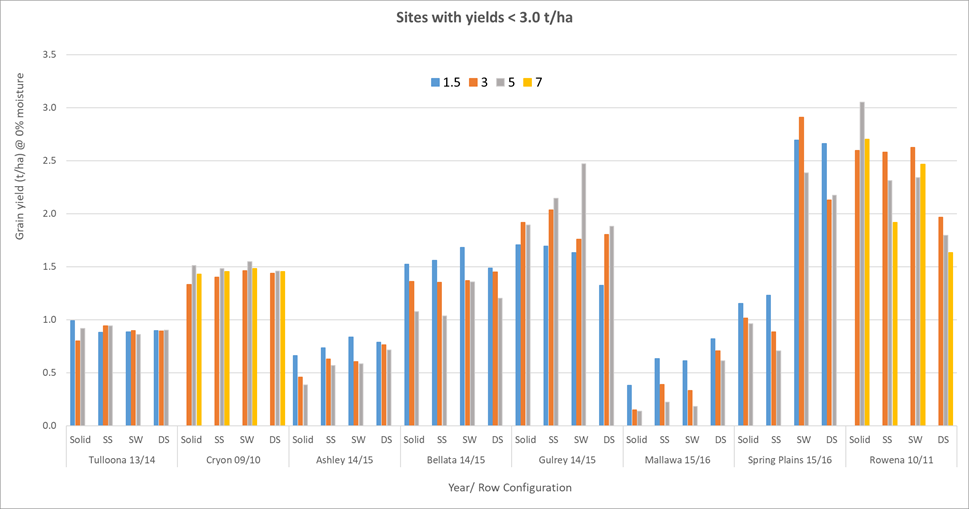 Figure 7. Trial sites with grain yields < 3.0 t/ha. Response to varying plant population (plants/m2) and row configuration in sorghum across NW NSW from 2010-2016. (Solid = solid plant, SS = single skip, SW = super wide (150 cm solid) DS = double skip).
Figure 7. Trial sites with grain yields < 3.0 t/ha. Response to varying plant population (plants/m2) and row configuration in sorghum across NW NSW from 2010-2016. (Solid = solid plant, SS = single skip, SW = super wide (150 cm solid) DS = double skip).
Early sown crops often have reduced establishment, hence more seeds may need to be sown to achieve the target plant population. The other important point to consider when deciding on a plant population is that population alone is not responsible for crop yield. The optimum population also depends on the row configuration and the level of tillering within different hybrid sorghum varieties.
Water use efficiency
Water use, more specifically, water use efficiency, is a critical component to sorghum crop success in the western zone. The higher the water use efficiency, the more kilograms of grain will be produced for each millimetre of water supplied.
Sowing sorghum into cooler soil affects plant development, extending the number of growing days required to reach flowering. However, as temperatures are lower during this time of the year (August – October), the crops evaporative demand is also expected to be lower.
Therefore, it was anticipated that early sown sorghum would use less water in the vegetative stages, which would mean additional water in the soil profile would be available for the grain fill period. Using the Agricultural Production Systems Simulator (APSIM), simulations of total crop water use for the 8 trial sites between central QLD and the Liverpool Plains in the 2018-19 season (Figure 8) showed that more water was used during the grain filling stage in the early sown sorghum (TOS 1), compared to time of sowing 3 (TOS 3), the normal sowing time.
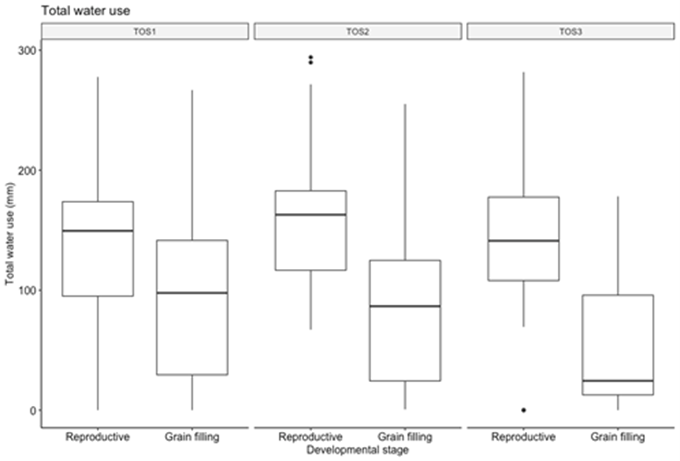 Figure 8. APSIM simulated water use (mm) between floral initiation and flowering (reproductive) and after flowering (grain filling) periods for all the treatments and sites trialled during the first season of trials (18-19).
Figure 8. APSIM simulated water use (mm) between floral initiation and flowering (reproductive) and after flowering (grain filling) periods for all the treatments and sites trialled during the first season of trials (18-19).
Measurement of in-crop water use of two hybrids(MR Buster and Agitator)at Breeza in 2018-19 showed water use efficiency to be higher in TOS 1 and TOS 2 when crops were sown into cooler soil temperatures (11.2 and 10.3 °C) compared to the normal sowing time of TOS 3(Table 1). There was no difference between plant populations or hybrids in this season.
Table 1. Water use efficiency (kg/ha/mm) predictions at Breeza 2018-19 (averaged across population and hybrid).
Sowing time | Water use efficiency (kg/ha/mm) |
|---|---|
Very early (TOS 1) | 6.51a |
Early (TOS 2) | 5.68 a |
Normal (TOS 3) | 2.44b |
L.s.d: 2.25
In the following season (2019-20), there was an interaction between sowing times and plant populations. Water use efficiency declined as plant population increased for both TOS 1 and TOS 2 (Figure 4). There was no difference between populations for TOS 3 which was sown into higher soil temperatures. MR Buster had a higher water use efficiency than Agitator in this season.
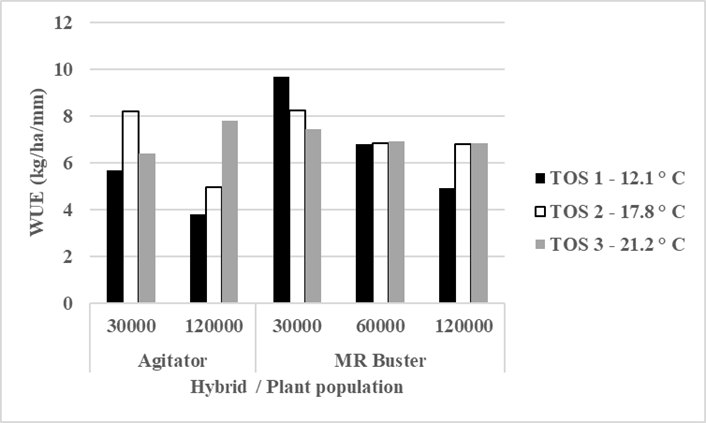 Figure 9. Water use efficiency response to varying sowing time at Breeza 2019-20
Figure 9. Water use efficiency response to varying sowing time at Breeza 2019-20
(LSD = 2.61 kg/ha/mm)
The next step in data collection to better understand water use in early sown sorghum is planned to occur this coming season. Additional measurements of water use in the vegetative and reproductive stages are planned for the Mungindi and Breeza sites, compared across populations and hybrids.
Conclusions
A complete package that will help to reduce risk and improve the reliability of sorghum production in NW NSW is hopefully only one more season of data away. A series of options for improving confidence in growing sorghum in this region have been examined. However, further interrogation of the available data sets combined with additional trial data from this coming season will help provide localised data, especially around crop water use and flowering windows.
To date, early sown sorghum has provided benefits which have far outweighed the risks. The integration of additional tools to help growers develop knowledge and skills around seed quality (germination and vigour), improving establishment and better predictions of hybrid flowering will only serve to improve our confidence in sorghum production.
The ideal management package will suggest avoidance of the peak heat and moisture stress periods in NW NSW and generate a profitable sorghum grain yield with optimised water use efficiency, whilst still maintaining system benefits such as stubble cover from a cereal crop. This is a significant challenge for the future of our industry, but also a massive opportunity waiting to be exploited.
Acknowledgements
The research undertaken as part of this project is made possible by the significant contributions of growers through both trial cooperation and the support of the GRDC, the author would like to thank them for their continued support.
The support of Andrew Earle “Bullawarrie” Mungindi, Tom Greentree “Morialta” Mungindi, Michael Brosnan, Alexandra McDonnell B&W Rural Mungindi, Geoff Manchee & JR McDonald “Bogamildi” Moree, and Rob Holmes, Alex Trindall & Liz McDonald, HMAg is gratefully acknowledged.
Thanks also to Lucy Loveridge, Mathew Dunn, Simon Tydd, Scott Goodworth, NSW DPI for their technical support in the conduct of the trials and to Tendo Mukasa Mugerwa for editing the paper.
Contact details
Loretta Serafin
NSW Department of Primary Industries
4 Marsden Park Road, Calala
Ph: 0427 311 819
Email: Loretta.serafin@dpi.nsw.gov.au
GRDC Project Code: DAN00150, UOQ1808-001RTX,
Was this page helpful?
YOUR FEEDBACK
